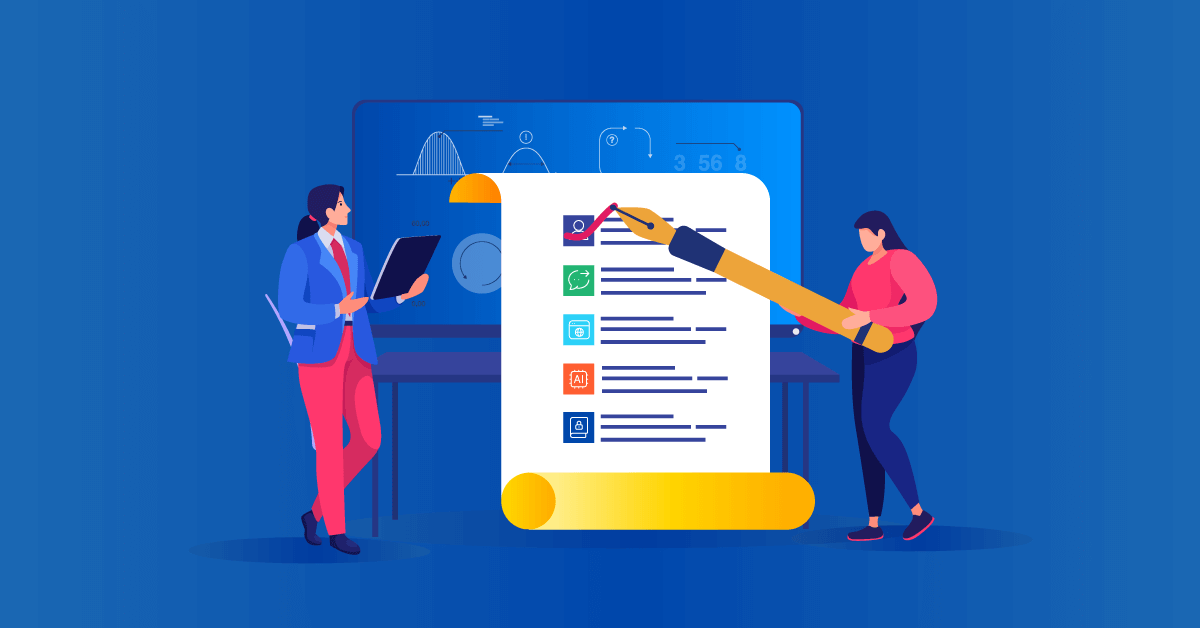Learning and employee development are key concerns in any organization. You want to give your employees all the resources they need to succeed in their jobs. But you’re not limited to formal training. Or, at least, you shouldn’t. Informal learning helps employees strengthen their skills and continue learning outside the traditional setting of a meeting room or online workshop.
In this article, we’ll discuss when and why you should use informal learning in the workplace. We’ll also offer some best practices. But first, let’s define exactly what informal learning is.
What is informal learning?
Informal learning definition: Informal learning is education that occurs outside a structured learning environment. It happens when learners are driven by their own interests. When they learn through experiences and content available outside of predefined, formal training.
Informal learning examples: This kind of learning can take many forms. Some common ones include educational videos and articles, self-study, social media interaction, on-the-job mentoring, or even team activities and games.
Informal education is generally self-directed. But that doesn’t mean you can’t engage employees in it intentionally. You can design informal training that supports your organization’s learning strategy (more on that later).
Even when it’s intentional, however, informal learning is different from formal training.
Formal vs. informal learning
Formal learning is structured and often mandated. It has very clear objectives and tends to favor a trainer-centered approach where the goal is getting specific content across to students. It includes specific progress schedules and testing to ensure knowledge transfer.
Informal learning, on the other hand, is learner-centered. It’s based on the idea that the learner can self-motivate, self-correct, and self-evaluate in the learning process.
When to use formal learning
Formal learning is at the heart of most learning strategies, and for good reasons. Employees need to have the technical skills and knowledge to do their jobs. They also need the soft skills required to work with colleagues and clients.
In addition, some training is mandated, either by the organization, by the industry regulations, or by the government. Compliance training, for example, ensures that organizations operate in an ethical, fair, and accountable manner.
In these cases, formal training will communicate what learners need to know and ensure that they learn it in a reasonable timeframe.
When to use informal learning
Informal education is a great outlet for reflective practice or hands-on learning. It can be especially beneficial when you want L&D to be an ongoing process.
Often learning is more complete when it happens over time. Skills or knowledge gained through formal training can be reinforced through outside activities and resources.
Keep your formal and informal learning in one place with TalentLMS
The training platform that users consistently rank #1.
Easy to set up, easy to use, easy to customize.
The benefits of informal learning
Fostering a culture of informal learning can offer your organization many benefits. For example:
- Learning informally is less intimidating for many people. The lack of exams or tight deadlines can put learners at ease and make it easier to commit to learning a new skill or a concept.
- When a more experienced employee informally mentors others, it transfers knowledge but also improves workplace relationships.
- Time and cost barriers are almost non-existent in informal learning. There’s little to no development time or learning costs.
- Informal learning is driven by learner interests. This reduces boredom and allows for more self-directed learning outside of formal programs.
- Informal learning activities are a natural part of day-to-day working so they don’t disrupt schedules.
- People have been learning informally their whole lives. When they have the resources and can freely follow their interests, learning will happen naturally.
There are plenty of reasons to engage informal learning in your organization. So what does it look like?
Examples of informal learning in the workplace
Some informal learning is completely unstructured and happens spontaneously. That doesn’t mean you can’t build an environment that creates opportunities for it.
These kinds of learning opportunities include:
- Mentoring. Senior employees share strategies or insights they’ve learned over the course of their careers with their colleagues. When employees have opportunities to work together, it fosters the kinds of working relationships that lead to natural mentoring.
- Online forums and social media. Internal communication options (for example, Slack channels or company social media pages where employees can interact) are common learning environments. People can share articles, watch videos, and ask and answer questions. These outlets are places people come together to learn and teach one another.
- Memberships to professional groups. Often, employees join local teams of an industry organization or professional improvement groups to foster their own learning. They engage in networking that improves their industry knowledge by expanding their professional community.
- Team building activities. These aren’t just a way to blow off steam or socialize. They also help employees learn to work together and rely on one another.
- Online learning resources. Many organizations use their learning management system (LMS) to encourage informal learning that supports their formal training. They offer a library of resources that dive deep on key principles—for example, videos, case studies, interactive exercises, or quizzes. These help users refresh their understanding of key training content. These are available on-demand, and learners have flexibility in choosing which content they look at and in what order.
Meet TalentLibrary™
A growing collection of ready-made courses that cover the soft skills
your teams need for success at work
![]()

Informal learning in remote work settings
With the recent shift to more remote workforces, facilitating informal learning may seem more difficult. But the increased use of digital communication tools has expanded opportunities for remote employees to engage in less structured learning. Distance doesn’t have to be a barrier.
For example, remote teams can still use messaging apps to keep them sharing information and ideas. Informal workshops or lunchtime talks from senior employees over video conferencing can get employees connected with topics they may have an interest in that serves their jobs.
And don’t forget online learning resources. One of the greatest benefits of an LMS is that learners can log in anytime, from anywhere. And many systems also provide LMS mobile apps so employees can engage in remote learning from their smart devices.
Informal learning can be a great tool regardless of your team’s location. The key is to not leave it up to chance. You can create a culture of informal learning when you adhere to a few basic principles and practices.

The do’s and don’ts of informal learning
Informal training can support your overall training strategy when you encourage it. You can build in opportunities for learning that complements your training when you pay attention to the following four tips.
1. DO emphasize practice
Hands-on experience is a strong way to reinforce learning both during and after a structured course. Create learning opportunities that emphasize engagement and practice. For example, include branching scenarios for practice in your LMS library of resources. Or, consider starting team meetings with a scenario to work through based on what people learned in the training.
These kinds of role-playing and simulation exercises give learners the chance to try skills, fail, and recover in a safe environment. They provide opportunities for workshopping, problem-solving, and discussion. They also help reinforce and strengthen what people have already learned.
2. DON’T leave learning up to chance
Informal does not mean undesigned. Your instructional design skills are still majorly valuable in planning informal learning experiences.
When designing workshops, opportunities for collaboration, and resources, incorporate triggers for recalling previous information. Or, add prompts to research new information to get people engaging in deeper learning on their own.
You might also build opportunities for informal learning into your LMS. Provide self-study courses as part of your library of informal learning resources. Or, create forums where learners can discuss and share experiences and insights related to what they’re learning.
3. DO create communities
Focus your informal learning methods not only on personal experience but also on shared experience. Find ways to offer more opportunities for employees to interact and learn from one another.
As mentioned, messaging apps and social media can be great ways for people to share resources and learn. You can create opportunities to share knowledge, observations, and personal stories by setting up internal social media pages or Slack channels. Then help curate content or make sure internal SMEs engage with the pages or groups to help set a professional tone.
Where it’s possible to meet in person, you might hold roundtable discussions at the beginning of team meetings. Or, maybe offer optional team activities or lunchtime seminars. You can have subject matter experts, senior employees, or outside industry professionals share insights or experiences on relevant topics.
4. DON’T be tempted to over-curate learning
The whole point of informal learning is for people to learn independently. To make learning a fluid part of their work experience. If you try to control opportunities for learning too much, you’re just fostering more formal learning.
To cultivate a true culture of informal learning, you need to let learners be in control. Keep it simple to keep from over-curating. Here are a few tips on how to do that:
- Provide just-in-time information. Create resources that learners can turn to when they’re stuck, and right in the middle of a situation. Something easy to access whenever, wherever, and that doesn’t require heavy reviews or hoops to jump through.
- Keep it short. Avoid adding extra information to the resources you provide. Instead, give learners the tools to find additional information as needed. Let them drive their own learning experience by linking to resource guides, internal blogs, or tips from SMEs.
- Involve learners in teaching. Pull enthusiastic learners into resource-creation where possible. Use interviews or articles by team members to add authenticity to the informal learning experience and keep the community active.
Boost employee training with informal learning
You can’t, and arguably shouldn’t, control how your employees learn everything they need to do their jobs and thrive at work. But with the help of a versatile LMS and our tips and tricks, you can craft informal learning experiences that make employees want to keep learning.
Originally published on: 25 Nov 2015



